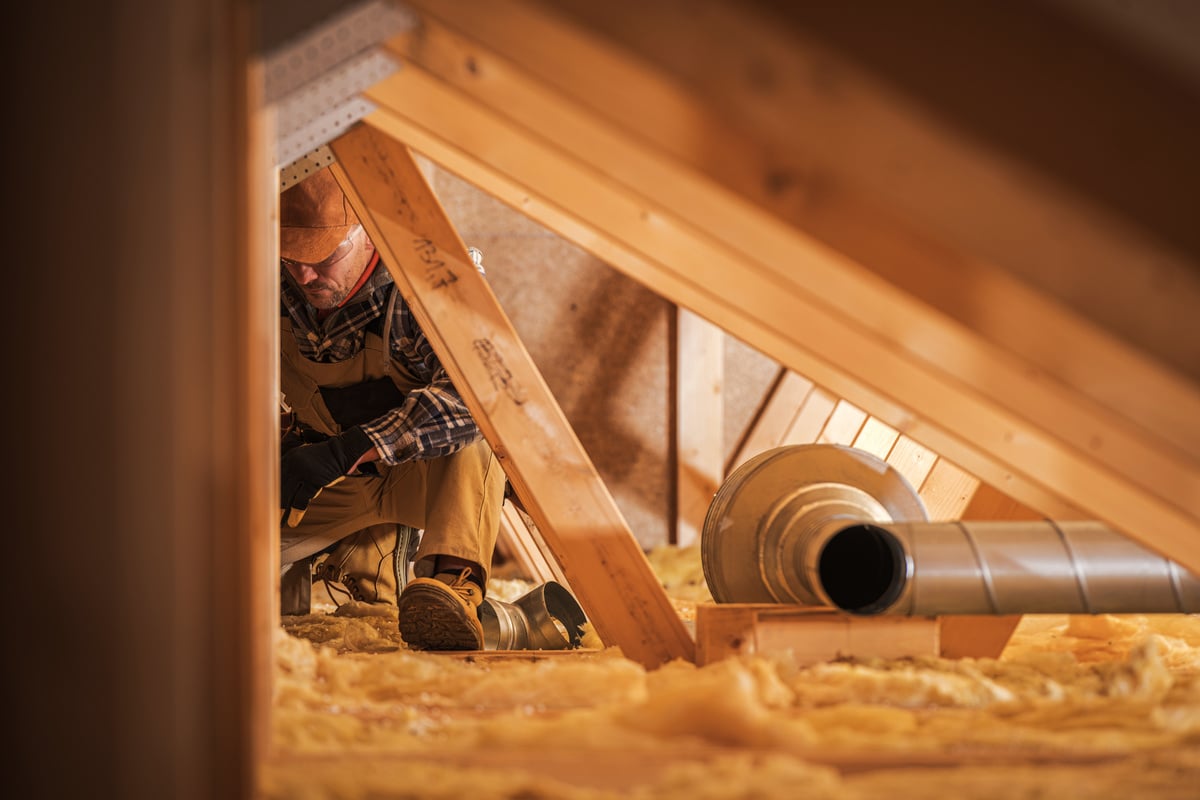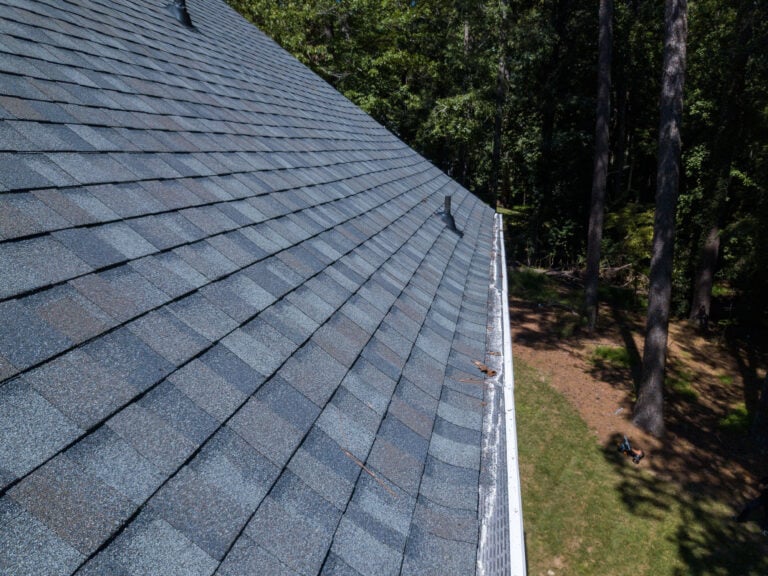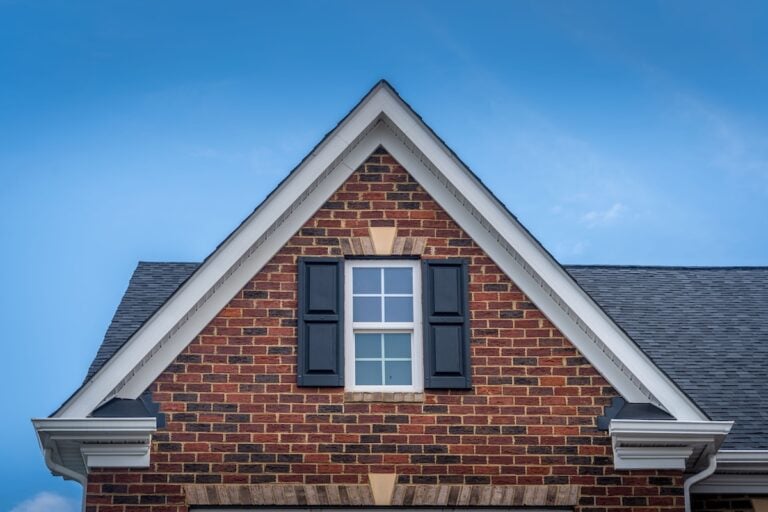Attic insulation is a critical component of home energy efficiency. Proper insulation can significantly reduce heating and cooling costs, improve indoor comfort, and increase the overall value of your home. Failing to properly insulate your attic can lead to roof damage and potential structural damage. Additionally, poor insulation can result in moisture buildup, promoting mold growth and weakening the roof’s integrity. This comprehensive guide will explore:
- Attic insulation cost, including factors influencing prices, cost breakdowns, and installation and replacement costs,
- Types of insulation
- Benefits of insulation
- DIY tips
- Reasons to hire professionals
- Money-saving tips
- FAQs
🏠 Areas in an Attic Space that Require Insulation
When insulating an attic, it’s essential to ensure all key areas are adequately covered to maximize energy efficiency and comfort. The primary areas that require insulation include:
- Attic Floor: Insulating the attic floor helps prevent heat from rising into the attic during the winter and keeps cool air from escaping during the summer.
- Attic Ceiling and Roof Decking: This helps regulate temperature and protect against roof damage caused by ice dams.
- Attic Walls: If your attic is used as a living space, insulating the walls is crucial to maintain a comfortable environment.
- Eaves and Dormers: These smaller areas can often be overlooked but are important for comprehensive insulation.
- Around Vents, Ductwork, and Pipes: Properly insulating around these features can prevent air leaks and energy loss.
👉 Types of Insulation for an Attic
Several types of insulation can be used in an attic, each with its own advantages and costs:
- Fiberglass Batts: One of the most common and affordable options. They are easy to install and provide good thermal resistance.
- Blown-In Fiberglass: This type is ideal for filling in irregular or hard-to-reach areas.
- Blown-In Cellulose: Made from recycled paper products, it offers excellent thermal performance and is environmentally friendly.
- Spray Foam Insulation: Provides superior air sealing and high R-value but is more expensive.
- Rigid Foam Insulation: Offers a high R-value per inch and is useful for insulating attic walls and floors.
- Reflective or Radiant Barrier Insulation: Reflects radiant heat away from the living space, especially useful in hot climates.
🤔 DIY Attic Insulation Information
Here you’ll find practical advice on preparing your attic, selecting the right materials, and following safe installation practices to ensure effective and efficient insulation when doing it yourself.
Benefits of DIY Insulation
- Cost Savings: Doing the job yourself can save on labor costs.
- Flexibility: You can work at your own pace and schedule.
Steps to Insulate Your Attic
- Assess Current Insulation: Determine the existing insulation levels and identify areas needing improvement.
- Choose the Right Insulation: Select the type of insulation that best fits your needs and budget.
- Prepare the Attic: Seal any air leaks, clean the area, and ensure proper ventilation.
- Install the Insulation: Follow manufacturer guidelines for installing the chosen insulation type.
- Inspect Your Work: Ensure the insulation is evenly distributed and covers all necessary areas.
Safety Tips
- Wear Protective Gear: Use gloves, goggles, and masks to protect against irritation and inhalation of particles.
- Avoid Electrical Hazards: Be cautious around wiring and light fixtures.
🧑🔧 4 Reasons To Hire a Professional for Attic Insulation
Hiring a professional for attic insulation ensures expert installation, compliance with building codes, and optimal energy efficiency. Professionals bring the necessary skills and equipment to complete the job safely and effectively, saving you time and potential future costs from improper installation.
1. Expertise and Experience
Professionals have the knowledge and skills to ensure proper installation, which can lead to better energy efficiency and insulation performance.
2. Quality Assurance
Hiring a professional guarantees that the insulation meets building codes and industry standards.
3. Time and Convenience
Professionals can complete the job more quickly and efficiently, saving you time and effort.
4. Safety
Professionals are equipped to handle any potential hazards and ensure a safe installation process.
💵 Average Cost of Attic Insulation
The average cost of attic insulation can vary widely based on factors such as the size of the attic, the type of insulation used, and local labor rates. Generally, homeowners can expect to spend between $1,500 and $3,500 for professional installation. DIY projects may cost significantly less, ranging from $500 to $1,200, depending on the materials chosen.
💰 Factors Influencing the Price of Attic Insulation
There are various elements that can affect your overall expenses, including attic size, insulation type, existing insulation condition, and local labor rates. Understanding these factors will help you budget effectively and make informed decisions for your insulation project.
Attic Size
Larger attics require more insulation material and labor, increasing the overall cost.
Type of Insulation
Different insulation materials come with varying price tags. For example, spray foam is typically more expensive than fiberglass batts or blown-in cellulose.
Existing Insulation
If the attic already has some insulation, you may only need to add more or replace damaged sections, potentially reducing costs.
Labor Rates
Local labor rates can significantly impact the cost of professional installation. Rates vary by region and contractor.
Additional Costs
- Air Sealing: Sealing air leaks before insulating can improve efficiency but adds to the overall cost.
- Ventilation Improvements: Ensuring proper attic ventilation might require additional work and expense.
- Removal of Old Insulation: If existing insulation needs to be removed, this will add to the project cost.
💰 Cost of Attic Insulation by Type
Here’s a breakdown of expenses associated with different insulation materials, including fiberglass batts, blown-in cellulose, spray foam, and more. Understanding these costs will help you make informed decisions based on your budget and insulation needs.
Fiberglass Batts
- Cost: $0.30 – $1.50 per square foot
- Installation: $1.50 – $3.00 per square foot
Blown-In Fiberglass
- Cost: $0.60 – $2.50 per square foot
- Installation: $1.50 – $3.00 per square foot
Blown-In Cellulose
- Cost: $0.50 – $2.00 per square foot
- Installation: $1.00 – $2.50 per square foot
Spray Foam Insulation
- Cost: $1.00 – $3.50 per square foot
- Installation: $2.00 – $5.00 per square foot
Rigid Foam Insulation
- Cost: $1.00 – $4.00 per square foot
- Installation: $2.50 – $6.00 per square foot
Reflective or Radiant Barrier Insulation
- Cost: $0.10 – $0.25 per square foot
- Installation: $0.50 – $1.00 per square foot
💰 Attic Insulation Installation Costs
The cost of installing attic insulation includes both materials and labor. Here’s a breakdown of what you can expect for professional installation:
- Fiberglass Batts: $1.50 – $3.00 per square foot
- Blown-In Fiberglass: $1.50 – $3.00 per square foot
- Blown-In Cellulose: $1.00 – $2.50 per square foot
- Spray Foam Insulation: $2.00 – $5.00 per square foot
- Rigid Foam Insulation: $2.50 – $6.00 per square foot
- Reflective or Radiant Barrier Insulation: $0.50 – $1.00 per square foot
💰 Attic Insulation Replacement Costs
If your attic insulation is old or damaged, replacing it can restore energy efficiency and comfort. Replacement costs typically include the removal of old insulation and the installation of new material. On average, homeowners can expect to pay between $1,500 and $5,000 for a full replacement, depending on the size of the attic and the type of insulation chosen.
🛠️ Benefits of Insulating Your Attic
Insulating your attic enhances energy efficiency, reduces heating and cooling costs, and improves overall indoor comfort. Additionally, it increases your home’s value and helps prevent issues like ice dams and moisture buildup.
- Energy Efficiency: Proper attic insulation reduces heat loss in the winter and heat gain in the summer, leading to lower energy bills.
- Improved Comfort: Insulation helps maintain a consistent indoor temperature, enhancing comfort year-round.
- Environmental Impact: Reducing energy consumption decreases your carbon footprint, contributing to environmental conservation.
- Increased Home Value: A well-insulated attic can increase your home’s market value and appeal to potential buyers.
- Prevention of Ice Dams: Proper insulation and ventilation can prevent the formation of ice dams, which can cause significant roof damage.
💡 Tips to Save Money on Attic Insulation
These tips will help you maximize your investment while ensuring effective insulation.
- DIY Projects: If you’re comfortable with home improvement tasks, consider a DIY insulation project to save on labor costs.
- Rebates and Incentives: Check for local, state, or federal rebates and incentives for energy-efficient home improvements.
- Bulk Purchases: Buying insulation materials in bulk can often reduce the overall cost.
- Compare Quotes: Get multiple quotes from contractors to ensure you’re getting the best price for professional installation.
- Timing: Consider insulating your attic during the off-season when contractors may offer discounts.
❓ 10 Frequently Asked Questions (FAQs)
1. How Much Does Attic Insulation Cost on Average?
The average cost of attic insulation ranges from $1,500 to $3,500 for professional installation. DIY projects can cost between $500 and $1,200.
2. What Type of Insulation Is Best for an Attic?
The best type of insulation depends on your budget, climate, and specific needs. Common options include fiberglass batts, blown-in fiberglass, blown-in cellulose, spray foam, rigid foam, and reflective insulation.
3. Can I Insulate My Attic Myself?
Yes, insulating your attic yourself can save on labor costs. However, it’s essential to follow safety guidelines and proper installation procedures.
4. How Long Does Attic Insulation Last?
Most types of attic insulation can last 20-30 years or more if properly installed and maintained. Regular inspections can help ensure its effectiveness over time.
5. What Are the Benefits of Hiring a Professional for Attic Insulation?
Professionals bring expertise, ensure quality installation, and can complete the job quickly and safely. They also ensure compliance with building codes and standards.
6. How Can I Save Money on Attic Insulation?
Consider DIY installation, look for rebates and incentives, buy materials in bulk, compare contractor quotes, and time your project for off-season discounts.
7. What Factors Affect the Cost of Attic Insulation?
Key factors include attic size, type of insulation, existing insulation, labor rates, and additional costs such as air sealing and ventilation improvements.
8. Is Attic Insulation Worth the Investment?
Yes, proper attic insulation can lead to significant energy savings, improved comfort, and increased home value, making it a worthwhile investment.
9. How Often Should Attic Insulation Be Replaced?
Attic insulation should be replaced if it is damaged, compressed, or no longer effective. Regular inspections can help determine when replacement is necessary.
10. What Is the R-Value, and Why Is It Important?
The R-value measures the insulation’s ability to resist heat flow. Higher R-values indicate better thermal performance. It’s important to choose insulation with an appropriate R-value for your climate and home.
Let Us Be Your Guide
By understanding the costs and benefits of attic insulation, you can make informed decisions to improve your home’s energy efficiency and comfort. Whether you choose to tackle the project yourself or hire a professional, investing in proper attic insulation is a smart and rewarding choice. Call us today to learn more about how we can make attic insulation easy for you.





